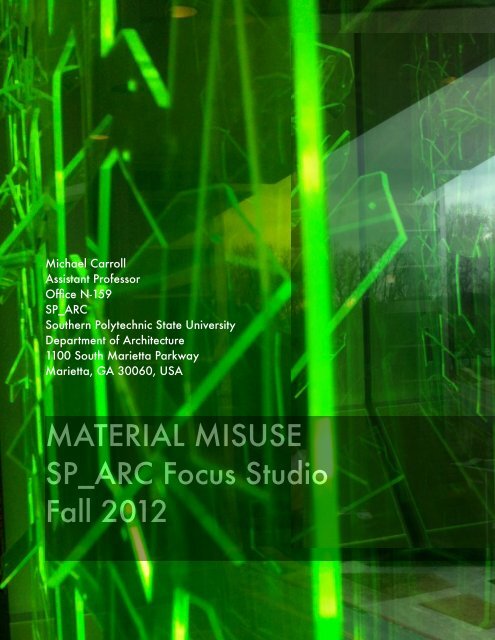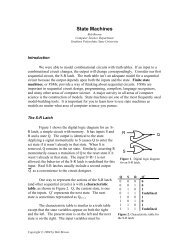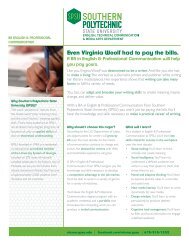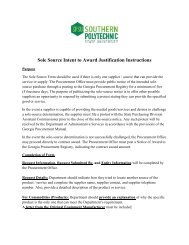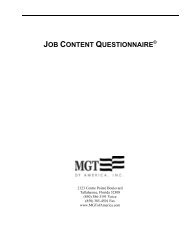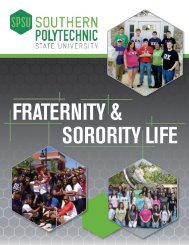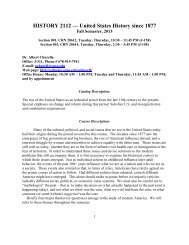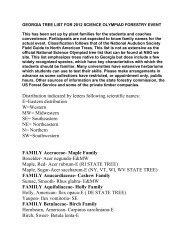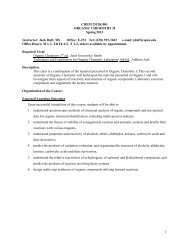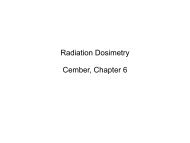Material Misuse - Southern Polytechnic State University
Material Misuse - Southern Polytechnic State University
Material Misuse - Southern Polytechnic State University
Create successful ePaper yourself
Turn your PDF publications into a flip-book with our unique Google optimized e-Paper software.
Michael CarrollAssistant ProfessorOffice N-159SP_ARC<strong>Southern</strong> <strong>Polytechnic</strong> <strong>State</strong> <strong>University</strong>Department of Architecture1100 South Marietta ParkwayMarietta, GA 30060, USAMATERIAL MISUSESP_ARC Focus StudioFall 2012
MATERIAL MISUSEARCH 5998F: Focus Studio<strong>Southern</strong> <strong>Polytechnic</strong> <strong>State</strong> <strong>University</strong> Department of ArchitectureFall 2012Michael Carroll, Assistant Professormcarrol2@spsu.eduOffice: N-159<strong>State</strong>ment of Pedagogical Approach“Architecture is ‘hyper-physical” Jacques HerzogMy philosophical and pedagogical approach within architectural design is centered onthe notion that thinking and making are integrated activities. Beyond a Cartesianphilosophy of the mind divided from the body, a phenomenological and thereforeexperiential architecture must address the human body through the engagement of thesenses beyond the visual. In this regard, an experiential architecture is not anabstraction but a material reality that is sensorial and radically physical. Within thismindset, architectural ideas are not abstract principles but are embodied within theconcrete and the material world.As a general pedagogical principle, teaching strategies must challenge each student'scomfort zone. In this regard, one of the goals of this Focus Studio is to foster a spirit ofplay and innovation within the studio through the MISUSE of materials. The objective ofmaterial misuse is to break material preconceptions through physical manipulations thatdistort, invert and potentially destroy material conventions.
Course Description:MATERIAL MISUSE will focus on issues of materiality and making, with the intention ofutilizing the extensive resources at SPSU Department of Architecture that include thewoodshop, SPSU <strong>Material</strong>s Library and digital fabrication facilities.In order to encompass both the digital and analogue techniques particular to thearchitectural design studio, the material investigations of the studio will focus, inparticular, on wood and polymers (plastics), both can be sourced as reclaimed or newmaterials and are easily manipulated in the wood shop and the digital lab.To enrich the spirit of experimentation within the studio, each student will be encouragedto challenge his/her common preconceptions of wood and plastic through a series ofexercises directed towards the MISUSE of the material at hand. Students will beencouraged, not only to acquire new materials but also to collect recycled, repurposedand found materials and distort and distress them through various means.Course Goals and Objectives:1) Develop an awareness of new and emerging material choices for both wood andpolymers. This will involve online research, use of SPSU <strong>Material</strong>s Library and visits tolocal suppliers, manufacturers and research institutes. Each student will be encouraged toproduce sample boards that indicate a range of innovative and emerging materialproducts.2) Challenge initial pre-conceptions of wood and polymers through a series of exercisesthat will focus on direct manipulation of materials in the creation of a series ofarchitectonic assemblages and constructions that will challenge 'traditional' techniques.(For example, instead of purchasing wood products, students will be encouraged to usesalvaged wood, tree bark, pine needles. In the case of plastics, heat can be applied tostretch and distort sheets of acrylic.)3) Explore a material's inherent architectural potential. This aspect will be explored inthe main architectural project of the studio, in which each student will design a publicpavilion that explores the potential of both wood and polymers to produce a range ofspatial experiences and architectural effects. Each student will be encouraged to useboth analogue and digital techniques to produce a series of physical constructs that willrange from gestural concept studies, sectional and façade study models to a large-scale'fragment' of the project's assembly system.
Exercises and Final Project:The semester will be divided up into a series of exercises that are designed to reinforce each other in thedesign of the final project for the semester.Project #1: <strong>Material</strong> MattersUsing the <strong>Material</strong> Connexion Online Database (or similar search engines), research emerging materialsand products in the category of wood and polymers. Source actual samples or create a facsimile tocreate a series of sample boards that includes technical data. <strong>Material</strong> research can also include woodand plastics with embedded technologies (smart materials).Project #2: MISUSE Experiments: WOODCollect an extensive array of used and new WOOD product, that ranges from, harvested bark, pinestraw, branches, driftwood, etc, to thin sheet veneers, dimensional lumber and timber. Distress thematerial through techniques such as hammering, scoring, scorching, dying, etc. Create a series ofarchitectonic objects that investigates various (mis)uses of the material at hand. This can include, but notlimited to, architectonic vessels, frames, screens and surfaces. Photograph various misuse experiments inWOOD, format and upload these photographic studies (with explanatory texts) to digital booklet.Project #3: MISUSE Experiments: PLASTICSCollect an extensive array of used and new PLASTIC product, that ranges from used PET water bottles,shopping bags and food packaging to clear, translucent and/or opaque sheets of polycarbonate andstyrene. Distress the plastic through techniques such as heating, scoring, scorching, bending, shredding,etc. Create a series of architectonic objects that investigates various (mis)uses of the material at hand. Thiscan include, but not limited to, architectonic vessels, frames, screens and surfaces. Photograph variousmisuse experiments in PLASTIC, format and upload these photographic studies (with explanatory texts) todigital booklet.Project #4: MISUSE 'Garden Folly' PAVILIONThe temporary garden pavilion will be situated on the Great Lawn of the Botanical Garden of PiedmontPark. The project will be similar in tone and scope to the London's Serpentine Gallery Pavilion. Eachstudent will be asked to create a pavilion that will investigate the combination of both plastic and wood inthe design of a provocative architectural project that engages the public through staging a series ofactivities and events that ranges (for example) from an afternoon café, an evening reception or a nightlyconcert. <strong>Material</strong> experimentation will be encouraged in the consideration of primary, secondary andtertiary structural systems, filtering and screening of natural light, envelope design, etc.The design of the pavilion might also include the design of seating, tables, counters, light fixtures, etc.EvaluationThe following is the breakdown percentages for the course:Project #1: <strong>Material</strong> Matters(Initial <strong>Material</strong> Research): 5%Project #2: MISUSE Experiments: WOOD 20%Project #3: MISUSE Experiments: PLASTICS 20%Project #4: MISUSE 'Garden Folly' PAVILION 45%Readings + Participation 10%
Throughout the semester, the studio will make use of publications that have beenpurchased for the SPSU <strong>Material</strong>s Library. Short excerpts from the following books willform the basis in-studio discussions throughout the semester.Addington, Michelle, Smart <strong>Material</strong>s and Technologies in Architecture, Oxford: Architectural Press,2005.Antonelli, Paola, Design and the Elastic Mind, New York: MoMA, 2008.Bell, Bellard, Victoria, <strong>Material</strong>s for Design, New York: Princeton Architectural Press, 2006.Beylerian, George, <strong>Material</strong> Connexion, New Jersey: Wiley Press, 2005.Borden, Gail and Meredith, Michael, MATTER, London and New York: Routledge, 2012.Brownell, Blaine, Transmaterial, New York: Princeton Architectural Press, 2006.Gramazio + Kohler, Digital <strong>Material</strong>ity in Architecture, Lars Muller Publishers, 2008Klooster, Thorsten, Smart Surfaces, Birkhauser, Berlin, 2009.McQuaid, Matilda, Extreme Textiles, New York: Princeton Architectural Press, 2005.Mori, Toshiko, Immaterial / Ultramaterial: Architecture, Design, and <strong>Material</strong>s, George Braziller,2002.Mori, Toshiko, Textile / Tectonic: Architecture, <strong>Material</strong> and Fabrication, George Braziller, 2005.Pallasmaa, Juhani, The Eyes of the Skin: Architecture and the Senses, 2nd Edition, London: John Wiley& Sons, 2005.Picon, Antoine, Digital Culture in Architecture, Basel: Birkhauser, 2010.Praxis: Journal of Writing + Building, Issue 1, Detail: Specificity in Architecture, 2000.Praxis: Journal of Writing + Building, Issue 6, New Technologies://New Architectures, 2004.Ritter, Axel, Smart <strong>Material</strong>s, Basel: Birkhauser, 2007.Schmidt, Petra, Un/Folded, Basel: Birkhauser, 2010.Willis, Daniel, The Emerald City: And Other Essays on the Architectural Imagination, New York:Princeton Architectural Press, 1999. See, “The Weight of Architecture”, “Seven Strategies for MakingArchitecture in the Twenty-First Century”, “The Work of Architecture in the Age of Efficient Production”.


